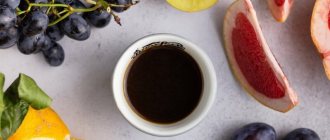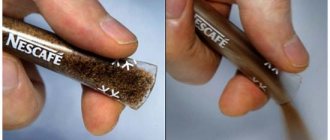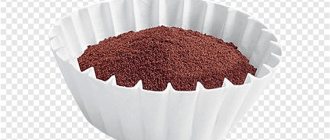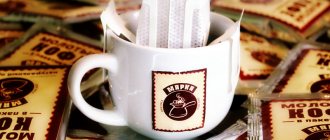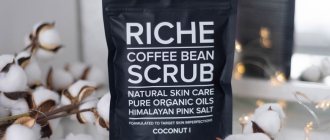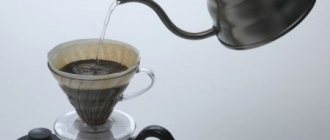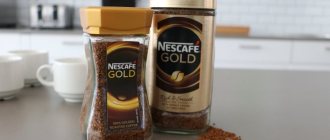Drip coffee is a portioned dry drink packaged in a special design. This packaging option makes it possible to prepare an invigorating drink by pouring hot water, and then removing the grounds, preventing them from getting into the cup. Coffee received its name precisely because of the brewing method.
The product is made of special multilayer filter paper. This paper is made from cellulose of natural origin. During production, the cellulose is not bleached or subjected to other chemical influences, so the contact of the drink with the paper is completely safe.
Many people confuse immersion brewing with the drip brewing option. The main difference between the first and the second is that during cooking, the grains are pre-soaked in water for several minutes to swell. When using filter paper, this preparation step is skipped.
Types of bagged coffee
Coffee bags for brewing in a cup are available in several variations:
- One serving, packed in a separate bag. When preparing a coffee drink, the contents are poured into a mug and filled with water.
- In filter bags equipped with a thread-shaped holder. Visually similar to classic tea bags, but larger in size.
- Drip pack. More advanced packaging. Thanks to the use of this option, the drink is obtained without grounds. This often becomes a decisive factor when choosing coffee products.
How to choose a drip coffee maker
A drip coffee maker (or filter coffee maker) is a fairly common device: you can buy it at any hardware store, it costs from 1000 rubles to infinity. When choosing a model, focus on the quality of the material, the desired volume, design and additional functions. All this will have a slight effect on the taste of coffee, but will make the preparation process more convenient and enjoyable.
All drip coffee makers, regardless of manufacturer and price, are designed the same way: they have a water tank, a heating element, a compartment for ground coffee and a coffee jug for the finished drink. The water heats up, rises in the form of a water-steam mixture through the tube to the coffee compartment, condenses and seeps through the coffee layer. Five to seven minutes - and a whole pot of aromatic drink is ready!
Another cup: 5 facts about coffee that will convince you of its benefits Read
Drip coffee
Drip bags for coffee have a special design that makes it possible to brew ground beans by pouring them, and then remove the grounds from the mug. The packaging is multilayer filter paper made from cellulose. It is not bleached. Accordingly, contact of coffee beans and water with such paper does not pose any danger.
The name of this product comes from the English “drip” and literally translates as “drop”. This term refers to the preparation technology, but it also refers to the packaging itself and the drink obtained from its use.
Content
- 0. Introduction
- 1. Properties and “enemies” of coffee beans
- 2. Types of coffee
- 3. Advantages and nuances of flexible packaging
- 4. Packaging composition: triplex and paper
- 5. Package types
- 5.1. Three-layer bags
- 5.1.1. For all types of coffee
- 1) Three-seam
- 2) Doypack
- 3) With side folds (folds)
- 4) With a flat bottom and folds (eight-seam quad-pack)
- 5) With welded edges
- 5.1.2. For ground coffee
- 1) Vacuum “briquettes”
- 5.1.3. For instant coffee
- 1) Sasha
- 2) Stick
- 5.2. Paper bags for coffee beans
- 6. Degassing valve, zip-lock and others
- 7. Conclusion
Types of single-serve coffee
Natural coffee bags come in different varieties. Typically, a mixture of several types of coffee beans is used. The following information is indicated on the packaging:
- 100% Arabica. It is a mixture of beans grown in different countries. Moreover, the composition contains only Arabica.
- Robusta and Arabica. The exact proportions must be indicated. The greater the concentration of Robusta, the stronger the drink.
- Blend. This term refers to a mixture containing grains grown in the same area.
If there are no marks on the packaging, the mixture can be absolutely anything. As a rule, low-grade raw materials are used in this case. It is strongly not recommended to opt for such coffee - you simply won’t be able to get a quality drink.
Manufacturers indicate a specific type of grain. For example, Tanzania Peaberry. Such products are classified as single varieties
Properties and “enemies” of coffee beans
As you know, each product has its own unique properties: color, smell, taste, etc. Coffee is no exception.
Initially, coffee beans are green in color. They are raw and acquire their familiar appearance only after roasting. And it is at this stage that difficulties arise.
Freshly roasted coffee is full of carbon dioxide, and the idea of immediately packaging it is a mistake. It has been experimentally proven that the bags will immediately explode under pressure. Therefore, it is better to ventilate the roasted grains first, but this process should not be prolonged.
It is obvious from the above that packaging coffee is not so simple. It must be technologically correct, otherwise the taste of the drink will deteriorate after 2 days.
So, proper packaging of coffee means fighting its main “enemies”:
- time;
- oxygen and moisture;
- products with a strong odor.
- Time. This refers to the period after roasting. In order for the released gas to evaporate, you need to let the grains lie in the open air. But the main thing in this matter is not to overdo it, since keeping grains in the fresh air for a long time is enemy No. 1. During a day in the open air, grains lose up to 40-60% of useful compounds, so it is better to ventilate them for no longer than 1-2 hours. This rule also applies to ground beans.
- Oxygen and moisture. The longer the grains are ventilated, the greater their interaction with oxygen. As a result, coffee loses essential oils and, as a result, oxidative processes accelerate. Moisture increases the weight of the product, but also has a detrimental effect on the quality of coffee.
- Products with a strong odor. Coffee absorbs odors and in order not to spoil the aroma of the drink itself, it is better to place it away from odorous goods.
By the way, even after proper ventilation, the grains will still emit gas and deform the packaging. This is precisely why the degassing valve was invented - an integral part of packaging for beans and ground coffee. More details about this in paragraph 6.
Pros and cons of different types
Disposable drip coffee bags and other packaging options have both advantages and disadvantages. To make the right choice, you need to compare the properties of the product, your requirements for its taste and cooking capabilities. Thanks to this, you will be able to know exactly which option will be the best.
Drip coffee
Ground coffee in drip bags is gaining popularity due to the following advantages:
- cooking speed - brewing takes about two minutes;
- Ease of use;
- no grounds remain in the cup;
- The quality of the drink is quite high.
The main advantage is its compact size. The bags are taken to work or on travel. You can enjoy a cup of aromatic coffee anywhere you have access to hot water.
Among the disadvantages of this type of product are the following:
- The price is an order of magnitude higher than a cup of regular espresso prepared in the classic way.
- You have to control the cooking procedure. Water is poured slowly. Only in this case will the ground grains fully release their aroma and taste.
- The product range is still relatively small.
Individually packaged
Among the advantages of coffee in bags of this variety are the following:
- compact packaging sizes;
- decent quality of the resulting drink;
- mobility - you can brew coffee anywhere as long as boiling water is available;
- simplicity of the preparation procedure.
The following disadvantages are identified:
- grounds will inevitably remain in the cup;
- high price;
- not always available even in large supermarkets;
- poor assortment.
In closed filter bags
Ground portioned coffee in this package has a number of advantages:
- convenient use;
- Compact size - bags are easy to store and transport.
The following are the disadvantages of this type of product:
- the quality of the resulting drink is low;
- the presence of grounds is noted in the circle;
- the price is the same as for drip packages;
- it takes a relatively long time to prepare - about five minutes;
- rarely found on sale.
Manufacturers and prices
Disposable bags
Not the most popular format. The main market share is shared by two manufacturers.
- Lavazza. If you manage to find it on store shelves, the cost will be about 400 rubles per pack. But the company does not particularly promote this product due to low demand.
- Madeo. They produce packs of 10 sachets. Price: from 400 rubles.
Filter packages
- Phuong Vyu. Vietnamese company. They sell 100% Arabica beans. Pack of 16 sachets. Cost - from 350 rubles.
- Bestcoffee. Product from Latvia. Budget - from 300 rubles per pack, of 10 bags. The quality of the grains is unknown.
Drip packages
- Coffesso. They were the first to bring this product to the Russian market. The coffee is of fairly high quality. A package of 5 bags will cost from 140 rubles.
- Coffee Yata. The company offers an assortment of several single varieties. The coffee is inexpensive and the quality is good.
- Blendy. The company belongs to the AGF concern - true Japanese quality. The coffee is good. The price is 250 rubles per pack of 8 sachets.
- Brand. The Russian manufacturer offers only one variety - Brazil Santos. 350 rubles per pack of 10 sachets.
How to brew correctly
Regular packaged coffee is brewed simply. To get the finished drink, you need to pour the contents of one sachet into a mug and pour boiling water into it. After 4-5 minutes you can enjoy the coffee taste and aroma.
It is no less easy to brew grains placed in special filter bags. The preparation procedure in this case is similar to brewing tea.
Ground coffee beans in paper packaging are placed in a cup, poured with boiling water and left to steep for 5 minutes.
Brewing coffee packed in drip bags deserves special attention. The procedure boils down to performing the following actions:
- Unpack the portion of ground beans placed in foil.
- Remove the square bag.
- The handles of the bag, made of cardboard, should be straightened and pulled to the sides.
- Attach cardboard handles to opposite edges of the mug.
- After this, pour boiling water into the filter bag in a thin stream. Take these steps slowly. It takes at least a minute to fill a 200 ml container.
- Infuse the drink for a couple of minutes.
- Take the bag by the cardboard handles, pull and thus remove it from the mug.
Ground coffee beans in bags are an opportunity to prepare your favorite drink in any conditions, and in a short period of time. Therefore, this type of product is becoming more and more popular. There are several types of packaging. Everyone can choose the option that suits them by studying each of the varieties and learning the intricacies of their use.
Packaging composition: triplex and paper
Engineers make coffee packaging from:
- dense polymer film BOPP, OPP, PP, PET, APET, PE;
- kraft or offset paper.
However, take a look at any coffee bag. Its outer surface showcases a bright and colorful design, product name and logo, while the interior has a foil-like finish.
In reality, coffee bags consist not of one film, but of three layers of different films - triplex.
- The first, inner layer is polyethylene (PE). This polymer is highly durable and can withstand the effects of acids, alkalis, alcohols and even fats. Thanks to it, the package is sealed and resistant to external influences.
- The second layer is foil (AL) or a metallized layer of BOPP or PET. This is the main feature of triplex. The purpose of the foil or metallized layer is to isolate the product from moisture and ultraviolet rays, as well as protect the product from foreign odors.
- The outer layer - lavsan (PET) or bio-oriented polypropylene (BoPP) - has little effect on the preservation of coffee. It is used as a basis for printing. Therefore, manufacturers are trying to select a material on which the dye adheres well in order to apply high-quality flexo printing.
Thus, triplex is a common basis for creating coffee packaging. This is explained by the property of coffee to release essential oils and the need to preserve them inside the package. And it is the foil that ensures the preservation of the original quality of the product.
Natural (Brown) Coffee Filters: The Basics
Natural filters are easier to produce and less harmful to the environment (after all, paper is made from wood and its natural color is brown), but without first rinsing the filter, you risk introducing the taste and aroma of cardboard into your cup.
It's worth noting that using a white filter does not completely protect you from cardboard taste, as the quality of bleaching and manufacturing plays a big role. Therefore, regardless of the brand, type of paper filters or their bleaching technology, rinsing before use should not be neglected.
Degassing valve, zip-lock and others
Degassing valve
As mentioned in the first point, coffee produces gas. The package contains 4 times more carbon dioxide than grains, and if you do not install a valve, the package will explode.
Peculiarities:
- releases carbon dioxide, does not let oxygen in;
- increases the shelf life and shelf life of coffee;
- preserves the rich taste and aroma of the drink.
A nice bonus: when you squeeze the bag through the valve, you can feel the aroma of coffee.
Zip-lock
It is a small seam (lock) at the top of the package.
Peculiarities:
- retains the aroma of coffee when opening/closing the bag again;
- makes it possible to close the bag multiple times without using clothespins or other objects;
- protects coffee from moisture, dust, air.
Breakaway line
Thanks to it, you don't need to take scissors to easily open the package.
Other modifications: rounded corners, partial or complete varnishing, a notch for easy quick opening, a cut-out hole or a Euro slot for hanging the package on a display case.
Quality and thickness of filters
While we're just talking about differences in filter processing technology, don't forget that filter quality and thickness are just as important to the purity and repeatability of your brew profile, as well as your overall flow rate. A slight difference in the thickness of filters from the same package can create different tastes in seemingly identical cups.
Choose filters that are most suitable for your cooking method and always pay attention to their thickness. If the filter is too thin, the water will spill too quickly, and if it is too thick, less oils will get into your drink and this can negatively affect its health.
Instant coffee “3 in 1”, “cappuccino”, “latte”, etc.
Perhaps the most affordable and at the same time the most ambiguous type of coffee. Despite the ease of preparation, it has a number of disadvantages that a real coffee lover will put up with once or twice, but not all the time: a lot of sugar (from 40 to 75% of the total mass of soluble powder), little coffee (10–15%), and an ingredient billed as “cream”, it is a complex component based on vegetable protein.
When brewing a portion of this “coffee”, you should not count on a pronounced invigorating effect. Rather, this drink is similar to a sweet dessert with coffee flavor. To get the usual dose of caffeine, you will have to drink a concentrate of 2-3 packets and at the same time feel a slight overdose of carbohydrates.
Pros:
easy to prepare, reasonable price.
Minuses:
low caffeine content, a large number of additives, high calorie content, a lot of sugar, taste is not for everyone.
How to replace the filter at home
If necessary, a purchased filter can be replaced with improvised means, which, although they will not allow you to make an absolutely clean drink, are useful for one-time retention of grounds.
The following materials are suitable:
- a piece of calico or cotton fabric;
- paper napkins;
- a piece of gauze folded in several layers.
Making coffee using a filter greatly simplifies the process of creating a tasty and aromatic drink. It doesn’t matter which model you choose, because if used correctly, it will serve faithfully for the time allotted to it.

